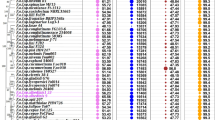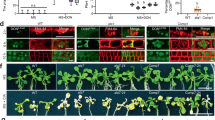Abstract
Fusarium oxysporum f. sp. lycopersici is an important plant pathogen that has been used to understand the virulence mechanisms that soil inhabiting fungi exhibit during the infection process. In F. oxysporum many of the virulence factors are secreted, and the secretion process requires the formation of vesicles. Arf family members, represented by Arf (ADP- Ribosylation Factor), Arl (Arf-like), and Sar (Secretion-associated and Ras-related) proteins, are involved in the vesicle creation process. In this study we identified the Arf family members in F. oxysporum f. sp. lycopersici, which includes seven putative proteins: Arf1, Arf3, Arl1 through Arl3, Arl8B, and Sar1. Quantification of the mRNA levels of each arf encoding gene revealed that the highest expression corresponds to arf1 in all tested conditions. The phylogenetic analysis revealed that no other Arf1 paralogue, such as Arf2 from yeast, is present in F. oxysporum f. sp. lycopersici. The essential function suggested of Arf1 in F. oxysporum f. sp. lycopersici was corroborated experimentally when, after several attempts, it was impossible to obtain a knockout mutant in arf1. Moreover, arl3 mRNA levels increased significantly when plant tissue was added as a sole carbon source, suggesting that the product of these genes could play pivotal roles during plant infection, the corresponding mutant ∆arl3 was less virulent compared to the wild-type strain. These results describe the role of arl3 as a critical regulator of the virulence in F. oxysporum f. sp. lycopersici and stablish a framework for the arf family members to be studied in deeper details in this phytopathogen.





Similar content being viewed by others
References
Agrios G (2005) Plant pathology 5th Edition. San Diego Acad Press. https://doi.org/10.1016/j.plantsci.2005.02.019
Al-Hatmi AMS, Meis JF, de Hoog GS (2016) Fusarium: molecular diversity and intrinsic drug resistance. PLoS Pathog 12:e1005464. https://doi.org/10.1371/journal.ppat.1005464
Araiza-Cervantes CA, Meza-Carmen V, Martínez-Cadena G, Roncero MIG, Reyna-López GE, Franco B (2018) Biochemical and genetic analysis of a unique poly(ADP-ribosyl) glycohydrolase (PARG) of the pathogenic fungus Fusarium oxysporum f. sp. lycopersici. Antonie van Leeuwenhoek 111(2):285–295. https://doi.org/10.1007/s10482-017-0951-2
Askun MBE-T (2018) Fusarium: Historical and Continued Importance. IntechOpen, Rijeka, p Ch. 2. https://doi.org/10.5772/intechopen.74147
Bourne HR, Sanders DA, McCormick F (1991) The GTPase superfamily: conserved structure and molecular mechanism. Nature 349:117–127. https://doi.org/10.1038/349117a0
Brenner S (1974) The genetics of caenorhabditis elegans. Genetics 77(1):71–94
Casadevall A, Nosanchuk JD, Williamson P, Rodrigues ML (2009) Vesicular transport across the fungal cell wall. Trends Microbiol 17:158–162. https://doi.org/10.1016/j.tim.2008.12.005
Carroll AM, Sweigard JA, Valent B (1994) Improved vectors for selecting resistance to hygromycin. Fungal Genet Rep 41:22. https://doi.org/10.4148/1941-4765.1367
Colicelli J (2004) Human RAS superfamily proteins and related GTPases. Sci Signal. https://doi.org/10.1126/stke.2502004re13
Csépányi-Kömi R, Lévay M, Ligeti E (2012) Small G proteins and their regulators in cellular signalling. Mol Cell Endocrinol 353:10–20. https://doi.org/10.1016/j.mce.2011.11.005
Dean R, Van Kan JAL, Pretorius ZA, Hammond-Kosack KE, Di Pietro A, Spanu PD, Rudd JJ, Dickman M, Kahmann R, Ellis J, Foster GD (2012) The top 10 fungal pathogens in molecular plant pathology. Mol Plant Pathol 13:414–430. https://doi.org/10.1111/j.1364-3703.2011.00783.x
Delic M, Valli M, Graf AB, Pfeffer M, Mattanovich D, Gasser B (2013) The secretory pathway: exploring yeast diversity. FEMS Microbiol Rev 37:872–914. https://doi.org/10.1111/1574-6976.12020
Dereeper A, Guignon V, Blanc G, Audic S, Buffet S, Chevenet F, Dufayard JF, Guindon S, Lefort V, Lescot M, Claverie JM, Gascuel O (2008) Phylogeny.fr: robust phylogenetic analysis for the non-specialist. Nucleic Acids Res 36:W465–W469. https://doi.org/10.1093/nar/gkn180
Di Pietro A, Roncero MI (1998) Cloning, expression, and role in pathogenicity of pg1 encoding the major extracellular endopolygalacturonase of the vascular wilt pathogen Fusarium oxysporum. Mol Plant Microbe Interact 11:91–98. https://doi.org/10.1094/MPMI.1998.11.2.91
Donaldson JG, Jackson CL (2011) ARF family G proteins and their regulators: roles in membrane transport, development and disease. Nat Rev Mol Cell Biol 12:362–375. https://doi.org/10.1038/nrm3117
Fiedler MRM, Cairns TC, Koch O, Kubisch C, Meyer V (2018) Conditional expression of the small GTPase ArfA impacts secretion, morphology, growth, and actin ring position in Aspergillus niger. Front Microbiol 9:878. https://doi.org/10.3389/fmicb.2018.00878
Garcia-Ranea JA, Valencia A (1998) Distribution and functional diversification of the ras superfamily in Saccharomyces cerevisiae. FEBS Lett 434(3):219–225. https://doi.org/10.1016/s0014-5793(98)00967-3
Gillingham AK, Munro S (2007) The small G proteins of the Arf family and their regulators. Annu Rev Cell Dev Biol 23:579–611. https://doi.org/10.1146/annurev.cellbio.23.090506.123209
Gordon TR (2017) Fusarium oxysporum and the Fusarium Wilt Syndrome. Annu Rev Phytopathol 55:23–39. https://doi.org/10.1146/annurev-phyto-080615
Jackson CL, Bouvet S (2014) Arfs at a glance. J Cell Sci 127:4103–4109. https://doi.org/10.1242/jcs.144899
Joshi R (2018) A review of Fusarium oxysporum on its plant interaction and industrial use. J Med Plants Stud 6:112–115. https://doi.org/10.22271/plants.2018.v6.i3b.07
Kahn RA, Volpicelli-Daley L, Bowzard B, Shrivastava-Ranjan P, Li Y, Zhou C, Cunningham L (2005) Arf family GTPases: roles in membrane traffic and microtubule dynamics. Biochem Soc Trans 33:1269–1272. https://doi.org/10.1042/BST0331269
Kahn RA (2006) ARF family GTPases. Springer, Netherlands
Kronstad JW, Attarian R, Cadieux B, Choi J, D’Souza CA, Griffiths EJ, Geddes JM, Hu G, Jung WH, Kretschmer M, Saikia S, Wang J (2011) Expanding fungal pathogenesis: Cryptococcus breaks out of the opportunistic box. Nat Rev Microbiol 9:193–203. https://doi.org/10.1038/nrmicro2522
Lee SC, Schmidtke SN, Dangott LJ, Shaw BD (2008) Aspergillus nidulans ArfB plays a role in endocytosis and polarized growth. Eukaryot Cell 7:1278–1288. https://doi.org/10.1128/EC.00039-08
Lee SC, Shaw BD (2008) Localization and function of ADP ribosylation factor a in Aspergillus nidulans. FEMS Microbiol Lett 283:216–222. https://doi.org/10.1111/j.1574-6968.2008.01174.x
Ma L-J, Geiser DM, Proctor RH, Rooney AP, O’Donnell K, Trail F, Gardiner DM, Manners JM, Kazan K (2013) Fusarium Pathogenomics. Annu Rev Microbiol 67:399–416. https://doi.org/10.1146/annurev-micro-092412-155650
Manikandan R, Harish S, Karthikeyan G, Raguchander T (2018) Comparative proteomic analysis of different isolates of Fusarium oxysporum f. sp. lycopersici to exploit the differentially expressed proteins responsible for virulence on tomato plants. Front Microbiol 9:420. https://doi.org/10.3389/fmicb.2018.00420
Memon AR (2004) The role of ADP-ribosylation factor and SAR1 in vesicular trafficking in plants. Biochim Biophys Acta: Biomembr 1664:9–30. https://doi.org/10.1016/j.bbamem.2004.04.005
Muhammed M, Fuchs BB, Wu MP, Breger J, Coleman JJ, Mylonakis E (2012) The role of mycelium production and a MAPK-mediated immune response in the C. elegans-Fusarium model system. Med Mycol 50:488–496. https://doi.org/10.3109/13693786.2011.648217
Nirmaladevi D, Venkataramana M, Srivastava RK, Uppalapati SR, Gupta VK, Yli-Mattila T, Clement Tsui KM, Srinivas C, Niranjana SR, Chandra NS (2016) Molecular phylogeny, pathogenicity and toxigenicity of Fusarium oxysporum f. sp. lycopersici. Sci Rep 6:21367. https://doi.org/10.1038/srep21367
Pantazopoulou A (2016) The Golgi apparatus: Insights from filamentous fungi. Mycologia 108:603–622. https://doi.org/10.3852/15-309
Patiño-Medina JA, Valle-Maldonado MI, Maldonado-Herrera G, Pérez-Arques C, Jácome-Galarza IE, Díaz-Pérez C, Díaz-Pérez AL, Araiza-Cervantes CA, Villagomez-Castro JC, Campos-García J, Ramírez-Díaz MI, Garre V, Meza-Carmen V (2019) Role of Arf-like proteins (Arl1 and Arl2) of Mucor circinelloides in virulence and antifungal susceptibility. Fungal Genet Biol 129:40–51. https://doi.org/10.1016/j.fgb.2019.04.011
Patiño-Medina JA, Maldonado-Herrera G, Pérez-Arques C, Alejandre-Castañeda V, Reyes-Mares NY, Valle-Maldonado MI, Campos-García J, Ortiz-Alvarado R, Jácome-Galarza IE, Ramírez-Díaz MI, Garre V, Meza-Carmen V (2018) Control of morphology and virulence by ADP-ribosylation factors (Arf) in Mucor circinelloides. Curr Genet 64:853–869. https://doi.org/10.1007/s00294-017-0798-0
Pareek M, Rajam MV (2017) RNAi-mediated silencing of MAP kinase signalling genes (Fmk1, Hog1, and Pbs2) in Fusarium oxysporum reduces pathogenesis on tomato plants. Fungal Biol 121:775–784. https://doi.org/10.1016/j.funbio.2017.05.005
Pfaffl MW (2001) A new mathematical model for relative quantification in real-time RT-PCR. Nucleic Acids Res 29:e45. https://doi.org/10.1093/nar/29.9.e45
Sikes BA, Bufford JL, Hulme PE, Cooper JA, Johnston PR, Duncan RP (2018) Import volumes and biosecurity interventions shape the arrival rate of fungal pathogens. PLoS Biol 16:e2006025. https://doi.org/10.1371/journal.pbio.2006025
Stearns T, Kahn RA, Botstein D, Hoyt MA (1990a) ADP ribosylation factor is an essential protein in Saccharomyces cerevisiae and is encoded by two genes. Mol Cell Biol 10:6690–6699. https://doi.org/10.1128/mcb.10.12.6690
Stearns T, Willingham MC, Botstein D, Kahn RA (1990b) ADP-ribosylation factor is functionally and physically associated with the Golgi complex. Proc Natl Acad Sci 87:1238–1242. https://doi.org/10.1073/pnas.87.3.1238
Stiernagle T (2006) Maintenance of c. Elegans Worm Book 11:1–11
Takai Y, Sasaki T, Matozaki T (2001) Small GTP-binding proteins. Physiol Rev 81:153–208. https://doi.org/10.1152/physrev.2001.81.1.153
Thompson JD, Higgins DG, Gibson TJ (1994) CLUSTAL W: improving the sensitivity of progressive multiple sequence alignment through sequence weighting, position-specific gap penalties and weight matrix choice. Nucleic Acids Res 22:4673–4680. https://doi.org/10.1093/nar/22.22.4673
Valle-Maldonado MI, Jácome-Galarza IE, Gutiérrez-Corona F, Ramírez-Díaz MI, Campos-García J, Meza-Carmen V (2015) Selection of reference genes for quantitative real time RT-PCR during dimorphism in the zygomycete Mucor circinelloides. Mol Biol Rep 42:705–711. https://doi.org/10.1007/s11033-014-3818-x
Wennerberg K (2005) The Ras superfamily at a glance. J Cell Sci 118:843–846. https://doi.org/10.1242/jcs.01660
Yorimitsu T, Sato K, Takeuchi M (2014) Molecular mechanisms of Sar/Arf GTPases in vesicular trafficking in yeast and plants. Front Plant Sci 5:1–12. https://doi.org/10.3389/fpls.2014.00411
Funding
This work was supported by grants from Coordinación de la Investigación Científica, Universidad Michoacana de San Nicolás de Hidalgo (2.6, 2.35) México. MIV-M, JAP-M and VA-C and were supported by postgraduate fellowships from CONACYT, CAA-C was supported by a postdoctoral fellowship from the Mexican PRODEP-SEP (511-6/18-12862). MSL-B was supported by grants 27375-R from the Junta de Andalucia (Spain) and by PID2019-108045RB-100 from the Spanish Ministerio de Economia y Competitividad.
Author information
Authors and Affiliations
Contributions
CA A-C, MI V-M, JA P-M, VA-C, JBG-P, KL M-S, MI R-D and MS L-B participated in data acquisition and data interpretation; KL M-S, MI R-D and MS L-B provided reagents and participated in critical analysis, data interpretation, and revision of the article for intellectual content; V M-C participated in the conception and design of the study, data analysis and interpretation, and drafting of the article.
Corresponding author
Ethics declarations
Conflict of interest
The authors declare that they have no conflicts of interest.
Additional information
Publisher's Note
Springer Nature remains neutral with regard to jurisdictional claims in published maps and institutional affiliations.
Supplementary Information
Below is the link to the electronic supplementary material.
Rights and permissions
About this article
Cite this article
Araiza-Cervantes, C.A., Valle-Maldonado, M.I., Patiño-Medina, J.A. et al. Transcript pattern analysis of Arf-family genes in the phytopathogen Fusarium oxysporum f. sp. lycopersici reveals the role of Arl3 in the virulence. Antonie van Leeuwenhoek 114, 1619–1632 (2021). https://doi.org/10.1007/s10482-021-01628-1
Received:
Accepted:
Published:
Issue Date:
DOI: https://doi.org/10.1007/s10482-021-01628-1




